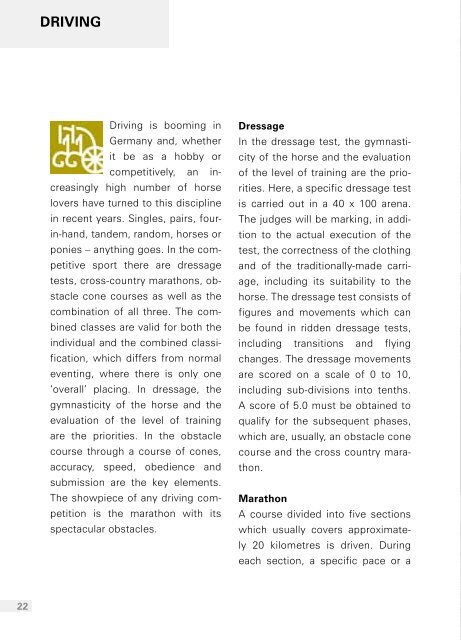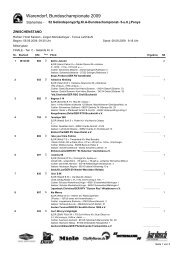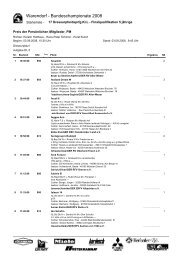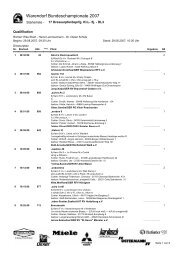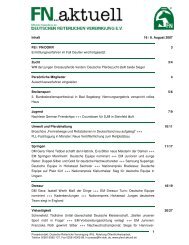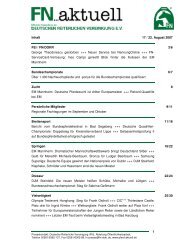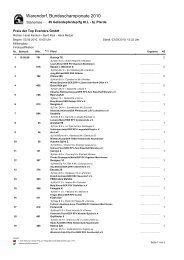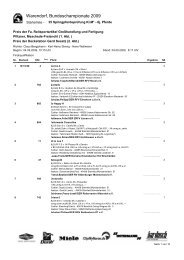DRESSAGE DRIvING ENDURANCE EvENTING JUMpING REINING ...
DRESSAGE DRIvING ENDURANCE EvENTING JUMpING REINING ...
DRESSAGE DRIvING ENDURANCE EvENTING JUMpING REINING ...
You also want an ePaper? Increase the reach of your titles
YUMPU automatically turns print PDFs into web optimized ePapers that Google loves.
22<br />
<strong>DRIvING</strong><br />
Driving is booming in<br />
Germany and, whether<br />
it be as a hobby or<br />
competitively, an increasingly<br />
high number of horse<br />
lovers have turned to this discipline<br />
in recent years. Singles, pairs, fourin-hand,<br />
tandem, random, horses or<br />
ponies – anything goes. In the competitive<br />
sport there are dressage<br />
tests, cross-country marathons, obstacle<br />
cone courses as well as the<br />
combination of all three. The combined<br />
classes are valid for both the<br />
individual and the combined classification,<br />
which differs from normal<br />
eventing, where there is only one<br />
‘overall’ placing. In dressage, the<br />
gymnasticity of the horse and the<br />
evaluation of the level of training<br />
are the priorities. In the obstacle<br />
course through a course of cones,<br />
accuracy, speed, obedience and<br />
submission are the key elements.<br />
The showpiece of any driving competition<br />
is the marathon with its<br />
spectacular obstacles.<br />
Dressage<br />
In the dressage test, the gymnasticity<br />
of the horse and the evaluation<br />
of the level of training are the priorities.<br />
Here, a specific dressage test<br />
is carried out in a 40 x 100 arena.<br />
The judges will be marking, in addition<br />
to the actual execution of the<br />
test, the correctness of the clothing<br />
and of the traditionally-made carriage,<br />
including its suitability to the<br />
horse. The dressage test consists of<br />
figures and movements which can<br />
be found in ridden dressage tests,<br />
including transitions and flying<br />
changes. The dressage movements<br />
are scored on a scale of 0 to 10,<br />
including sub-divisions into tenths.<br />
A score of 5.0 must be obtained to<br />
qualify for the subsequent phases,<br />
which are, usually, an obstacle cone<br />
course and the cross country marathon.<br />
Marathon<br />
A course divided into five sections<br />
which usually covers approximately<br />
20 kilometres is driven. During<br />
each section, a specific pace or a<br />
time (with both a minimum and a<br />
maximum time) is to be observed.<br />
The final section has eight obstacles<br />
which are to be negotiated as<br />
quickly as possible. The obstacle<br />
course can be covered in canter.<br />
Sports clothing is worn and a marathon<br />
carriage is usually attached.<br />
The grooms, sitting at the rear of the<br />
carriages, stabilise them through<br />
corners by shifting their weight and<br />
they will often tell the drivers which<br />
line to follow and which way to pass<br />
through the obstacles by calling loudly.<br />
Obstacle cone driving<br />
This phase is executed through<br />
a course of pairs of cones, with<br />
balls balanced on top of each cone.<br />
Speed, accuracy, obedience and<br />
submission of the horses are tested.<br />
Depending on the difficulty of<br />
the test, there can be up to 20 pairs<br />
of cones, placed between 20 - 50 cm<br />
wider than the wheels of the carriage.<br />
The pairs of cones are to be<br />
passed through as quickly as possible<br />
without the cone being moved<br />
or the ball, which is perched atop<br />
each cone, being dislodged. The<br />
pairs of cones are identifiable by a<br />
number, with the right cone having a<br />
red number and the left cone displaying<br />
a white number. Anybody who<br />
misses out a pair of cones or passes<br />
through from the wrong side is disqualified.<br />
The scoring follows two<br />
different methods. The first begins<br />
by counting first the faults and then<br />
the time so the winner is the one<br />
with the lowest number of penalty<br />
points; if there is a draw, then the<br />
quickest time determines the winner.<br />
Each obstacle which is knocked<br />
down counts as five penalty points.<br />
The second method of scoring adds<br />
five seconds to the eventual time for<br />
each penalty and the quickest competitor<br />
is declared the winner.<br />
23


